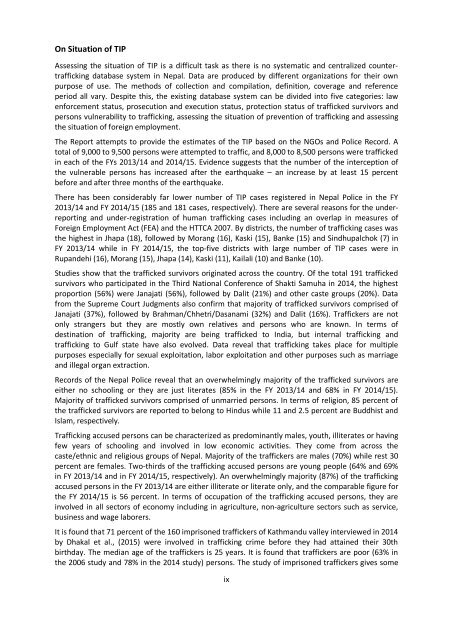TRAFFICKING IN PERSONS
1Spfyta
1Spfyta
You also want an ePaper? Increase the reach of your titles
YUMPU automatically turns print PDFs into web optimized ePapers that Google loves.
International Law found a number of irregularities associated with adoption processes and violation<br />
of the Purposes, Principles and Safeguards embodied in the 1993 Hague Inter-country Adoption<br />
Convention. Data is not available about the number of inter-country adoption before 1993. The<br />
number of inter-country between May 1993 and August 2008 was 2,234. The number of intercountry<br />
adoption has dramatically reduced in the FY 2013/14 and FY 2014/15 compared to the<br />
previous years. There were only 3 and 2 inter-country adoptions in the FYs of 2013/14 and 2014/15,<br />
respectively while it was more than 50 in the preceding years. This decline may be related to the<br />
strict terms and conditions for inter-country adoption adopted by the Government of Nepal. The<br />
surge of Nepal as a destination country of surrogate mothers may also relate to a decline of the legal<br />
inter-country adoptions. Much research, however, is needed to understand if there is any linkage<br />
between TIP and the growing phenomenon of surrogacy in Nepal.<br />
Missing children is often not taken as the trafficking of children. Realizing the linkage between<br />
missing children and trafficking, the Supreme Court of India ordered to the Union of India and States<br />
in May 10, 2013 that if the missing children are not found within four months of the first information<br />
report (FIR), the matter shall be forwarded to the Anti-Trafficking Unit and take up more intensive<br />
investigation regarding the missing child as trafficking. In Nepal, the reported number of missing<br />
children has considerably declined in the FYs of 2013/14 and 2014/15 compared to the previous<br />
years. However, the untraced rate has been more than 40 percent over the years – majority being<br />
girls (56%) against boys (31%). According to the record of the Women and Children Service<br />
Directorate (WCSD), Nepal Police, the five-yearly (2009/10 – 2013/14) average number of missing<br />
persons recorded exceeds 5,000. Of them, almost 74 percent were females and rest 26 are males. By<br />
age of the missing persons, 39 percent children and rest 61 percent were adults. Further, in FY<br />
2014/15, Nepal Police rescued a total of 425 children from different border points/regions of Nepal.<br />
Key challenges in relation to situation of TIP are related to developing the conceptual clarity about<br />
human trafficking, establishing a unified institutional mechanism to collect reliable statistical<br />
information, increasing the registration of TIP cases to Nepal Police, requiring greater attention,<br />
surveillance and monitoring in both formal and informal institutions, and targeting to a large number<br />
of children who are in vulnerable conditions, and obtaining disaggregated data of the trafficked<br />
survivors, especially of third gender.<br />
On Emerging Vulnerabilities of TIP after the Deadly Earthquakes of Mid-2015<br />
The earthquake of Nepal of April 25, 2015 with 7.8 Richter scale and a number of aftershocks has<br />
brought new challenges to combat TIP. It has not only worsened certain pre-existing vulnerabilities<br />
such as poverty, unemployment, discrimination but also created completely new ones. Hundreds of<br />
thousands of people lost their livelihoods, private property, well-being and employment<br />
opportunities. The death toll from such catastrophic trembler is estimated to have reached 8,790<br />
while 22,300 people have sustained injuries with about 300 accounted as still missing (MoF, 2015).<br />
The earthquake is estimated to have affected about one third (8 million) of the nation's population<br />
of 31 districts. The GoN has identified 14 districts as most affected districts, namely, Gorkha,<br />
Dhading, Rasuwa, Nuwakot, Kathmandu, Lalitapur, Bhaktapur, Makwanpur, Kavre, Sindhupalchok,<br />
Dolakha, Ramechhap, Sindhuli and Okhaldhunga.<br />
According to the National Planning Commission, NPC (2015) estimate, the total valuation of loss is<br />
Rs. 706,461 million. The highest amount of loss is in social sector (58%), followed by productive<br />
sector (25%), infrastructure (9.5%) and cross-cutting sector (7.5%). Among the individual sectors, it is<br />
the housing and human settlement that accounted almost half of the total estimated loss due to the<br />
earthquakes. It has been estimated that 5.7 million populations in 14 most affected districts have<br />
been directly affected by the quakes. Of them, female constitute 2.7 million and nearly one million is<br />
Dalit. Women, Dalit and marginalized groups will face a severe crisis as their already existing coping<br />
mechanisms and capacities are extremely low. Further, the proportion of poor in Nepal will increase<br />
by 2.8 percent (on the assumption of medium impact) into poverty in 2015/16. The proportions and<br />
xi


